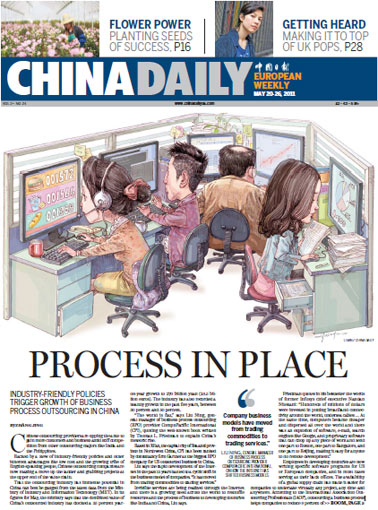Technology
The changing face of PR and marketing today
Updated: 2011-05-09 13:16
By Yang Ning (China Daily)
|
 Paul Mottram, executive vice-president for Asia-Pacific, Bite Communications. [Photo/Provided to China Daily] |
Social media is making businesses rethink their communications style
BEIJING - In today's digital era, no one can ignore the power of social media.
In China alone, the number of social-network users reached 207 million by the end of 2010, up 28 percent from the previous year. It is expected to hit 488 million by 2015, according to market research company eMarketer Inc.
Hardly heard of a few years ago, social media such as Facebook, Twitter and China's homegrown equivalents Renren and Sina Weibo are now becoming a top source for new traffic and referrals in business marketing and are key to consumer branding.
This form of social engagement has not only disrupted the norms of media and publicity, but has also fundamentally changed the landscape for marketers and brand builders, forcing communications to evolve, said a recent report released by Bite Communications, a global communications consultancy.
"Corporate communications have undergone a transformation because the social phenomenon has put a company's reputation directly in the hands of the public," said Paul Mottram, executive vice-president for Asia-Pacific of Bite Communications, in an interview with China Daily.
Based on a survey of more than 50 senior executives in public relations and marketing communications from Asia, Europe and North America, the report found general agreement that a company's reputation and brand identity are increasingly defined by public ideas rather than media advertising.
"That makes the art of corporate storytelling more important than it's ever been," said Mottram.
| ||||
Instead, the conversations often begin when someone - anyone - starts it online and its popularity is often defined by the involvement of outside influencers. Digital and social media empower the individuals to shape and spread ideas and end the stories.
"The most important information is now generated by a company's customers and critics, not necessarily by their public relations and marketing teams. Social media is touching every part of the marketing mix," Mottram said.
Far from meaning an end to public relations, this shift has led to a new beginning. The communicators' responsibility is to monitor and direct the constant conversation and thereby influence reputation, he added.
From Facebook to Twitter, from blog to podcast, every social media property and technology presents unique opportunities, challenges and threats. Therefore, today's communications teams have to understand the technical, cultural and practical specifics of these new media to take advantage, according to the report.
"Each channel does demand that communications teams understand its unique characteristics in incorporating them into their strategy," Mottram said.
Some progressive companies are utilizing the feedback of social media research in product development, customer service and ultimately in tactical and strategic management, he said.
According to Mottram, the organizations thriving in this brave new world share three key traits.
First, they have come to grips with their corporate values. Successful companies are more open and flexible and understand the vital difference between ownership and guidance of brand messages or stories.
Many companies are in the process of re-evaluating their values around sharing information that was once suppressed. Social media has affected crisis management by lowering the barriers to knowledge and publicity.
One company after another has suffered for trying to keep a lid on negative news, as others have been rewarded for openness with praise and loyalty. This dynamic has spurred some to change their philosophy toward openness.
Understanding these attitudes assists with every type of communication, from broad corporate messaging to individual conversations in the social sphere.
Second, successful organizations' communications strategy is practical and fully internalized at every level.
Effective strategies guide communications teams by providing touchstones that are applicable to daily operations. Every communications professional has a long list of "to-dos", but they can cut it considerably by being able to easily eliminate opportunities that don't fit.
To be most useful, strategy has to escape the c-level executives and be understood by all. Everyone from a new associate upward should be able to articulate the tenets at the core of the strategy in simple language.
Last but not least, policies are used to free employees by giving them structure. Clear social media policies enable employees to spread corporate stories positively.
It's rare that rules make for better communication. But when anyone in a socially-forward organization can find themselves speaking with external stakeholders, guidelines and policies are essential.
Any type of communication is at its best when it's authentic. Social media success demands that interactions take place between people who are informed and empowered.
Escalation happens quickly in the digital realm. In most situations, the first line of communication is the best place to deal with a problem. To do that effectively, people in every part of the organization need to understand their role as a communicator for the company, their latitude and restrictions.
E-paper

Green works
Wuxi becomes 'test case' for facing country's environmental challenges
Preview of the coming issue
The global rise of Chinese brands
China-EU trade on solid ground
Specials

The song dynasty
There are MORE THAN 300 types of Chinese operas but two POPULAR varieties are major standouts

Cut above the rest
One of the world's oldest surgeons has performed more than 14,000 operations

From the ground up
Architect of Guangzhou Opera House has many projects under way, including 2012 Olympics.




